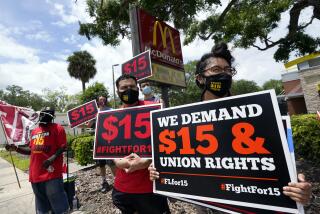Here’s what a ‘silver tsunami’ of retiring baby boomer business owners could mean for their workers
- Share via
As Labor Day arrives — and economic inequality rises on the political agenda — a little-noticed measure in the recently signed defense spending bill aims to address the widening wealth divide between workers and the owners or top executives who manage them.
The measure, co-sponsored by Sen. Kirsten Gillibrand (D-N.Y.), is intended to expand financing options and raise awareness for programs that can help employees become partial owners of the companies where they work.
The new provision could also help address what has been called a “silver tsunami” of retiring baby boomer business owners. Much has been made of what that generation’s departure from the workforce will mean — a loss of institutional knowledge, a shift in the job market and a drain on Social Security. But less attention has been paid to the wave of retiring boomers who own closely held private businesses. They will need to sell their companies, transition them to a new generation of owners — or risk shutting them down, cutting jobs in the process.
The provision, known as the Main Street Employee Ownership Act before it was added to this year’s defense bill, will make it possible for firms to use Small Business Administration loans to finance what’s known as employee stock ownership plans, or ESOPs, an arrangement that can help transfer ownership of the company to employees rather than have to find a suitable buyer or rely on family members who may be ill-suited or unprepared to keep the lights on.
In an ESOP, companies get tax incentives to either set up a trust fund into which they contribute shares or to finance the purchase of shares through a loan. Companies then give shares to all employees in amounts based on their relative pay or on a more equal basis.
The new provision also empowers the SBA to assist with employee ownership plans and raise awareness of the approach. The plans are used predominantly by closely held or privately owned companies and, to a much lesser extent, by some publicly traded companies, including Procter & Gamble.
The new measure is “the most significant policy change on employee share ownership in over two decades,” said Joseph Blasi, the director of the Institute for the Study of Employee Ownership and Profit Sharing at Rutgers University, who worked with Gillibrand’s office on the bill. Still, its immediate effect is probably limited to small companies: The SBA loans that can be used are capped at $5 million, though they can be combined with other financing.
But it’s also a rare bipartisan stab at finding a way to address the gap in wealth, according to Corey Rosen, founder of the National Center for Employee Ownership, a nonprofit membership group. One economist’s analysis found that the richest 1% of American households own 40% of the country’s wealth, the highest it has been in 50 years.
“We’re grasping for ways to deal with economic inequality and pretty much the two sides can’t agree on anything — except this,” Rosen said. “While this particular bill is just one step in that direction, it indicates here’s a path that’s worth exploring.”
As of the end of 2014, the average employee share in ESOPs of closely held private companies was $134,114, Blasi said. (The average 401(k) balance at the end of 2015 was $73,357, according to data from the nonprofit Employee Benefits Research Institute.) Workers can pocket the value of their shares from ESOPs only when they leave the company and sell the shares back to their employer.
While ESOPs can help workers build wealth, some research has shown benefits for employers. In a National Bureau of Economic Research study coauthored by Blasi, surveys of 40,000 workers showed that those with company stock plans were more likely to say they would intervene if they saw a colleague slacking off and far less likely to say they’d leave the company — as long as they didn’t feel micromanaged or like they weren’t involved in helping to solve company problems. (That could send a mixed message to workers: We’re going to give you ownership, but not make you feel like you have any.)
Another study found that companies that set up employee stock ownership plans were less likely than those without them to go bankrupt or disappear for other reasons.
And Paige Ouimet, a professor at the University of North Carolina’s business school, has found in research that publicly held companies with ESOPs had improved productivity. But whether more of the gains from higher profits went to employees (in the form of raises) or shareholders (in the form of higher stock prices) depended on whether there was a competitive labor market. She said it’s not always clear in some research whether companies perform better because they have employee ownership, or whether better-performing companies are just more likely to implement equity plans.
Employee ownership plans are far less prevalent among publicly traded companies, which may opt not to offer them for various reasons — investors may perceive they are a way to entrench managers with friendly employees, company officers could believe that equity should be reserved for top managers or top performers, or they may want to focus on more diversified retirement plan options. Meanwhile, employee stock ownership plans are complicated structures that mean additional governance issues, which could limit the growth of their use.
Still, some companies have decided to add them to give more employees access to equity, increase a sense of ownership among workers, and try to plan for the future. In June, Tuff Shed, the Denver-based maker of outdoor storage buildings, added an ESOP for its more than 1,300 employees after seeing that many of its employees weren’t participating in their 401(k) plan or getting the full company match.
CEO Tom Saurey could have made a straight, no-strings-attached contribution to workers’ 401(k) plans, but that wouldn’t have also helped him begin to plan for the future transition of his company once he’s ready to move on, said Phil Worth, the company’s vice president of marketing. The new plan will give most employees 3% of their salaries in the form of company stock held in an ESOP and still offer them a 401(k) to which they can contribute themselves.
Even if Saurey isn’t predicting he’ll go anywhere for more than a decade, an ESOP still helps the company prepare for that eventual handoff. “Who’s going to be in control of the company someday? If not [Saurey], who’s the most passionate about the company? Employees,” Worth said.
Making employees feel more like owners at the company was also a rationale.
“The day you give somebody a raise is great. Everybody feels good, but the lasting effect only goes so long,” he said. “A sense of ownership is a different conversation.”
More to Read
Inside the business of entertainment
The Wide Shot brings you news, analysis and insights on everything from streaming wars to production — and what it all means for the future.
You may occasionally receive promotional content from the Los Angeles Times.










